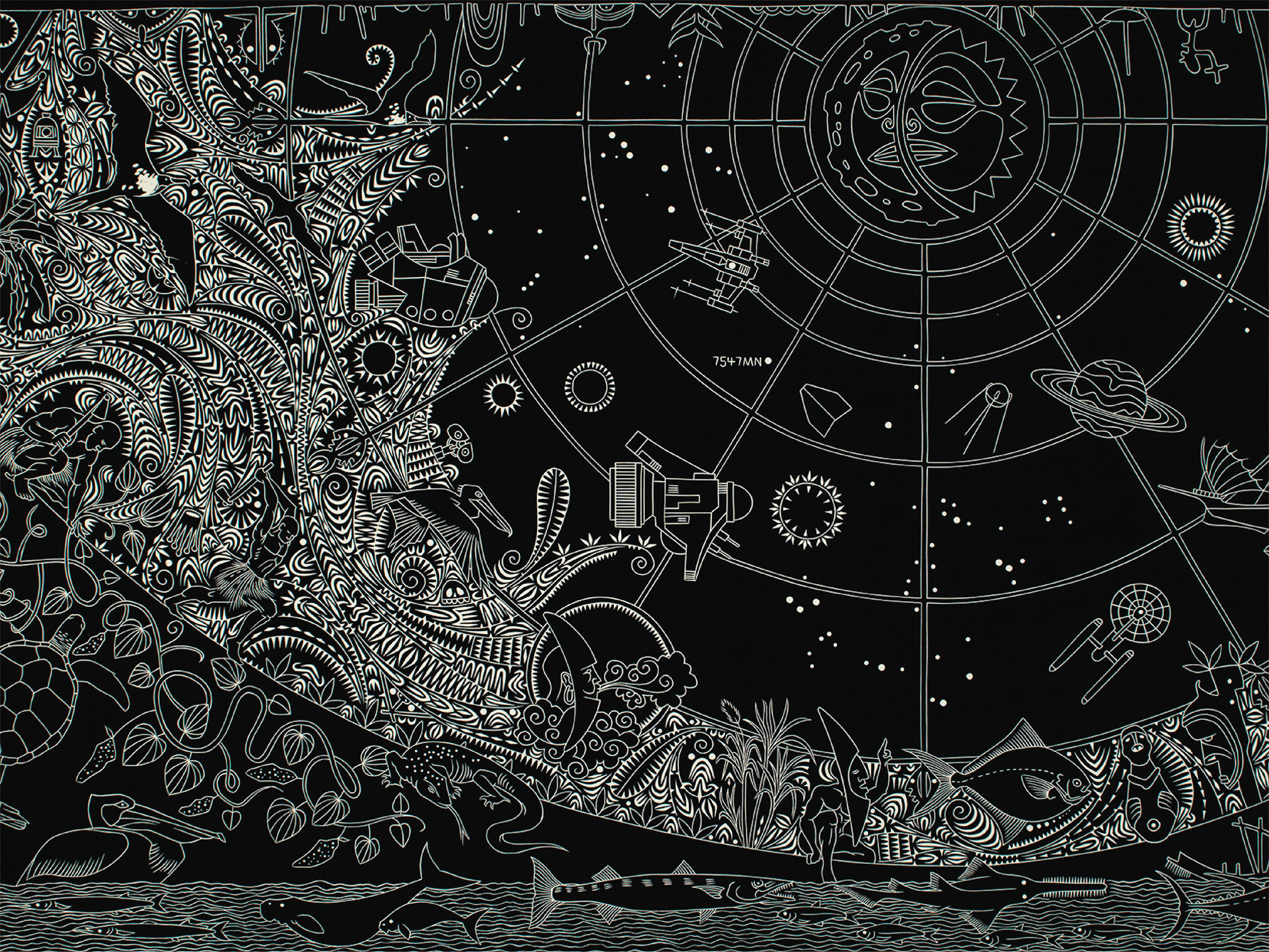
TORRES STRAIT SEASONAL CALENDAR
By Brian Robinson
Artist Brian Robinson shares the seasonal changes of the Torres Strait as an extension of his work in Shadow Spirit.
The Seasonal Calendar of Torres Strait life reflects the changes in the seas, the winds, the stars, and the land, and moves through cycles of abundance and scarcity, renewal, and harvest, wet and dry. As island cultures dependent on sedentary agriculture and fishing, they allowed the winds and tides to set the pace.
Bepo Taim (the time before) in the eastern islands there were four main seasonal times - Naiger, Koki, Ziai and Sager - each closely associated with the prevailing winds.
Naiger
Naiger (early October) began the cycle when the constellation of Tagai rose in the east. Firstly, at dusk, Usiam (the Pleiades) appeared in the north-east sky. Usiam-time (Pleiades-time) was the time of planting. It was regarded as a time of renewal, of re-beginning and it also marked the commencement of the ritual cycle, when, after preparations, voyaging expeditions to the Papuan mainland, other islands and Cape York took place for commodity and ritual exchanges. When the Southern Cross (Crux Australis) found the left hand of Tagai, it signalled to the gardeners that it was time to plant important yam varieties. Before the complete appearance of Tagai, garden preparations should have been completed.
Koki
In December, the appearance of a rainbow-like sunset signalled the arrival of Koki, generally a time of heavy rains, during which there was luxuriant growth. Planting continued using the tides and the moon to indicate the most propitious times. The prescriptive schedule indicated that when the tide was rising and flooding, planting should have been done and when the tide dropped, planting stopped. At new moon, vegetables that fruit above ground should be planted, and at full moon, plants with root food that grows down should be planted. When the full moon rises, sweet potato should be planted, making sure that it is positioned facing towards the full moon. The people took up residence in round houses on family lands along the sandy beaches for extra protection against the rains. Although vegetable products were scarce, bananas and coconuts were available, and fishing was very good, especially in the fish traps prepared by the people earlier in the cycle. Birds were hunted, particularly the frigate bird and the tern. In March, as the rains ceased with the cooler weather, it was Ziai. It was signalled by the winds turning around to the south.
Sager
Sager was signalled when the rainbow fish appeared, and the kingfisher returned to the islands in early April. Harvesting began in earnest, particularly of the yam. The planet Venus was the sign of the height of the harvest. Fish continued to be plentiful. Eugenia, the red-skinned apple-like fruit (Corvus in Tagai’s right hand), fruited and local ceremonies and feast offerings between reciprocal clans began. This season was one of replenishment, when grass-vine and bamboo-thatched house building and maintenance took place. Tools, weapons, fishing lines and nets were renewed and repaired. As the weather became drier and hotter from August onward, Naiger announced itself when the turtles began mating. Fishing was poor and vegetables were scarce. Garden preparation, using slash and burn techniques took place, as well as preparation activities, including outrigger-canoe maintenance.
For the westerly people of the islands of Mabuiag and Muralag in the Torres Strait, there were four main seasons - Surlal, Raz, Kuki and Aibaud.
Surlal
Surlal (mid-October to late November) began the yearly cycle and took its name from the readily caught copulating turtles, indicating their abundance as food. The Baidam or ‘shark constellation’, which consisted of the seven major stars of Ursa Major together with Arcturus (Alpha Bootis) and Gamma Corona Borealis, appeared low in the evening sky close to the reef. It was dry season, and all was withered and dried up but the yams harvested in the previous season were still available for eating. The sounding of the first thunder acted to signal the time for re-planting of the many varieties of yams. Raz (early December to late February) was described as the ‘time of die’, meaning the season when leaves fell from the plants and trees. Early in the season cashew nuts fell and young yams began to sprout. During mid-season, large numbers of jellyfish appeared and the runners on the yams began to grow.
Kuki
Kuki (early March to mid May) was the season when strong winds blew intermittently from the north-west, accompanied by deluges of rain. During the intervals between storms, it was very humid, there was no wind, and the seas became calm and glassy. The yams were not ready to eat so vegetables such as kolap (Matchbox bean) were eaten. The appearance of Altair (Alpha Aquilae), Beta and Gamma Aquilae (part of the Dogai constellation) and Bu, ‘the trumpet shell’ (Delphinus) heralded the beginning of the season.
Aibaud
Aibaud (late May to early October) was harvest season time, when roots were strong, and food (especially taro, sweet potato, and wild yam) was in abundance. The south-west winds began to blow steadily. The season was marked by the appearance of Vega (Alpha Lyrae), Beta and Gamma Lyrae, also part of the Dogai constellation. The appearance of a star known as Kek and Usal (the Pleiades), signalled the time for the performance of various ceremonies. When the crab, Getalar appeared, the birubiru birds migrated from Papua New Guinea south to Australia, as did the Torres Strait pigeons when Baidam, the shark constellation appeared heralding the beginning of another cycle. When only the tail of Baidam was above the horizon, the north-west wind began to blow a little, but when the tail had gone down altogether, it was time to begin to plant yams. When Baidam came up again, yams, sweet potatoes and bananas were ripe.